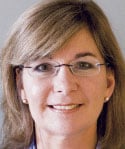 Karen Clark was sitting in front of a computer in the mid-1980s, mulling over problems the actuaries weren’t working on.
Karen Clark was sitting in front of a computer in the mid-1980s, mulling over problems the actuaries weren’t working on.
Commercial Union Assurance, her employer at the time, wanted to find a way to manage hurricane risk. Clark was told to figure out a way to determine the insurer’s probable maximum losses (PMLs), and she immersed herself in research.
“I got hooked on it,” Clark says. “I knew I wanted to build a computer model. I fell in love with the whole concept.”
Her research led to “A Formal Approach to Catastrophe Risk Assessment and Management,” a paper Clark wrote in 1986 for the Casualty Actuarial Society, in which she argued for a move toward probabilistic models rather than the subjective rules of thumb then used in underwriting.
Michael Wacek, at the time an actuary with E.W. Blanch, says he “immediately had that ‘Ah-ha! feeling’” upon reading the paper and told his senior executives to hire Clark.
“I knew this was exactly the way to go forward,” says Wacek, now an executive vice president at Odyssey Re.
“I told them no,” Clark says. “I wanted to start my own company.”
And Clark, having conceived the insurance industry’s first probabilistic catastrophe model, did just that, founding the first modeling firm, Applied Insurance Research, later AIR Worldwide. E.W. Blanch, the reinsurance predecessor to Aon Benfield, became her first client.
“She helped change the landscape of the P&C business,” says John Tierney, who worked with Clark at Commercial Union and is now chief actuary at Quincy Mutual. “The entire industry uses models for pricing and risk management.”
Clark says AIR had 30 clients, all reinsurers, when a bit of ironic serendipity proved to be a big boon to AIR—and eventually spawned an industry of competitors.
Hurricane Andrew slammed Florida in 1992—and it revealed that property insurers had “stopped tracking their exposures,” Clark says. “They didn’t know their accumulations.”
Regulators and ratings agencies realized it, too. And reinsurers, already accustomed to model usage, began requiring more specific exposure data.
“It took off—it snowballed,” Clark says of AIR’s model use. “It was something insurers could use to better estimate their loss potential and provide information to regulators and rating agencies.”
“The model gave reinsurers a guide for pricing their product and allowed property insurers to determine how much premiums to collect on the front end, in a much more sophisticated way,” adds Wacek.
Clark declined many offers in the years following Andrew but decided in 2002 to sell AIR to Insurance Services Office (ISO).
But within a few years, Clark says she came to realize that the use of the models was straying from the original purpose she had for them.
That epiphany came with the model-bashing following Hurricane Katrina in 2005.
“I was shocked,” Clark says of the aftermath. “I began meeting with [insurers and reinsurers], and I was horrified to learn that at the board level there was not a complete understanding of the wide uncertainty inherent in the models.”
Enhanced computing power was giving model users a false sense of their precision, perpetrating an “illusion of accuracy,” she adds.
In other words, the insurance industry was leaning on model outputs much more than Clark had ever intended.
“They are meant to give an estimate—a ballpark,” Clark says. “Companies were getting value from the tools but were relying on them too heavily, in particular on point-estimates such as PMLs.”
In response, she launched Karen Clark & Co. in 2007.
“I was energized,” Clark says. “Again I was driven by the fact that I knew there must be a better way. We could provide additional information and tools to help companies manage risk.”
Clark now strives to be an “independent, unbiased” provider of consulting services and tools that complement the models and allow companies to more efficiently develop proprietary views of their risk.
“It has been very exciting and gratifying,” Clark says. “It is continuously motivating to work with insurers and reinsurers to develop new ways to better understand and manage catastrophe risk.”
Want to continue reading?
Become a Free PropertyCasualty360 Digital Reader
Your access to unlimited PropertyCasualty360 content isn’t changing.
Once you are an ALM digital member, you’ll receive:
- Breaking insurance news and analysis, on-site and via our newsletters and custom alerts
- Weekly Insurance Speak podcast featuring exclusive interviews with industry leaders
- Educational webcasts, white papers, and ebooks from industry thought leaders
- Critical converage of the employee benefits and financial advisory markets on our other ALM sites, BenefitsPRO and ThinkAdvisor
Already have an account? Sign In Now
© 2024 ALM Global, LLC, All Rights Reserved. Request academic re-use from www.copyright.com. All other uses, submit a request to [email protected]. For more information visit Asset & Logo Licensing.








